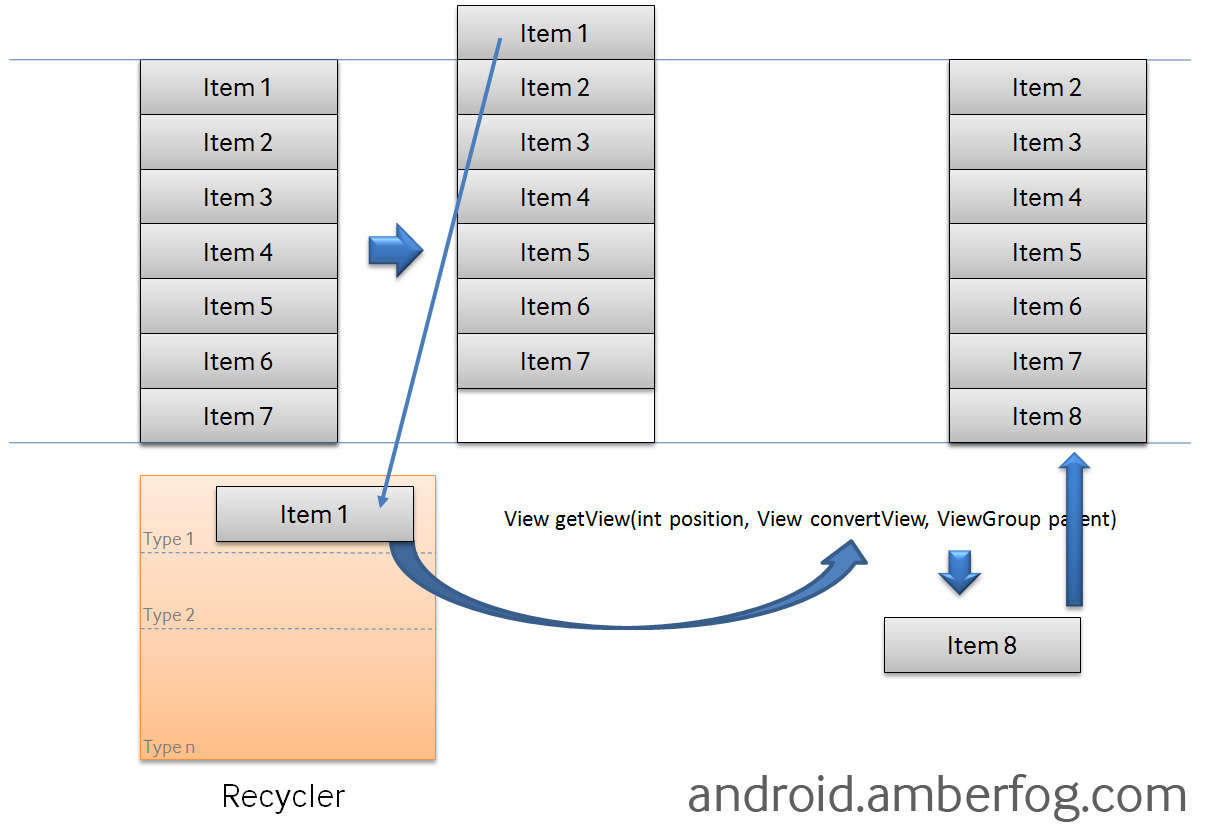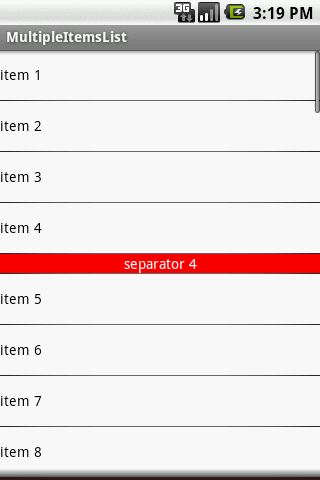标签:android style http io os ar java strong for
I was surprised that getViewTypeCount() is so rarely overrided. If you are an expert in this – this post is not for you)
ListView and Adapter Basics
How it works:
1、ListView asks adapter “give me a view” (getView) for each item of the list
2、A new View is returned and displayed
Next question – what if we have one billion items? Create new view for each item? The answer is NO,Android caches views for you.
There’s a component in Android called “Recycler”.

1、If you have 1 billion items – there are only visible items in the memory + view in recycler.
2、ListView asks for a view type1 first time (getView) x visible items. convertView is null in getView – you create new view of type1 and return it.
3、ListView asks for a view type1 when one item1 is outside of the window and new item the same type is comming from the bottom. convertView is not null = item1. You should just set new data and return convertView back. No need to create view again.
Let’s write a simple code and put System.out to the getView:
public class MultipleItemsList extends ListActivity {
private MyCustomAdapter mAdapter;
@Override
public void onCreate(Bundle savedInstanceState) {
super.onCreate(savedInstanceState);
mAdapter = new MyCustomAdapter();
for (int i = 0; i < 50; i++) {
mAdapter.addItem("item " + i);
}
setListAdapter(mAdapter);
}
private class MyCustomAdapter extends BaseAdapter {
private ArrayList mData = new ArrayList();
private LayoutInflater mInflater;
public MyCustomAdapter() {
mInflater = (LayoutInflater)getSystemService(Context.LAYOUT_INFLATER_SERVICE);
}
public void addItem(final String item) {
mData.add(item);
notifyDataSetChanged();
}
@Override
public int getCount() {
return mData.size();
}
@Override
public String getItem(int position) {
return mData.get(position);
}
@Override
public long getItemId(int position) {
return position;
}
@Override
public View getView(int position, View convertView, ViewGroup parent) {
System.out.println("getView " + position + " " + convertView);
ViewHolder holder = null;
if (convertView == null) {
convertView = mInflater.inflate(R.layout.item1, null);
holder = new ViewHolder();
holder.textView = (TextView)convertView.findViewById(R.id.text);
convertView.setTag(holder);
} else {
holder = (ViewHolder)convertView.getTag();
}
holder.textView.setText(mData.get(position));
return convertView;
}
}
public static class ViewHolder {
public TextView textView;
}
}

Different list items‘ layouts
Let’s move to the “more complicated” example. How about to add separator somewhere to the list.
You should do the following:
1、Override getViewTypeCount() – return how many different view layouts you have
2、Override getItemViewType(int) – return correct view type id by position
3、Create correct convertView (depending on view item type) in getView
Simple, isn’t it? Code snippet:
public class MultipleItemsList extends ListActivity {
private MyCustomAdapter mAdapter;
@Override
public void onCreate(Bundle savedInstanceState) {
super.onCreate(savedInstanceState);
mAdapter = new MyCustomAdapter();
for (int i = 1; i < 50; i++) {
mAdapter.addItem("item " + i);
if (i % 4 == 0) {
mAdapter.addSeparatorItem("separator " + i);
}
}
setListAdapter(mAdapter);
}
private class MyCustomAdapter extends BaseAdapter {
private static final int TYPE_ITEM = 0;
private static final int TYPE_SEPARATOR = 1;
private static final int TYPE_MAX_COUNT = TYPE_SEPARATOR + 1;
private ArrayList mData = new ArrayList();
private LayoutInflater mInflater;
private TreeSet mSeparatorsSet = new TreeSet();
public MyCustomAdapter() {
mInflater = (LayoutInflater)getSystemService(Context.LAYOUT_INFLATER_SERVICE);
}
public void addItem(final String item) {
mData.add(item);
notifyDataSetChanged();
}
public void addSeparatorItem(final String item) {
mData.add(item);
// save separator position
mSeparatorsSet.add(mData.size() - 1);
notifyDataSetChanged();
}
@Override
public int getItemViewType(int position) {
return mSeparatorsSet.contains(position) ? TYPE_SEPARATOR : TYPE_ITEM;
}
@Override
public int getViewTypeCount() {
return TYPE_MAX_COUNT;
}
@Override
public int getCount() {
return mData.size();
}
@Override
public String getItem(int position) {
return mData.get(position);
}
@Override
public long getItemId(int position) {
return position;
}
@Override
public View getView(int position, View convertView, ViewGroup parent) {
ViewHolder holder = null;
int type = getItemViewType(position);
System.out.println("getView " + position + " " + convertView + " type = " + type);
if (convertView == null) {
holder = new ViewHolder();
switch (type) {
case TYPE_ITEM:
convertView = mInflater.inflate(R.layout.item1, null);
holder.textView = (TextView)convertView.findViewById(R.id.text);
break;
case TYPE_SEPARATOR:
convertView = mInflater.inflate(R.layout.item2, null);
holder.textView = (TextView)convertView.findViewById(R.id.textSeparator);
break;
}
convertView.setTag(holder);
} else {
holder = (ViewHolder)convertView.getTag();
}
holder.textView.setText(mData.get(position));
return convertView;
}
}
public static class ViewHolder {
public TextView textView;
}
}

标签:android style http io os ar java strong for
原文地址:http://my.oschina.net/artshell/blog/322699